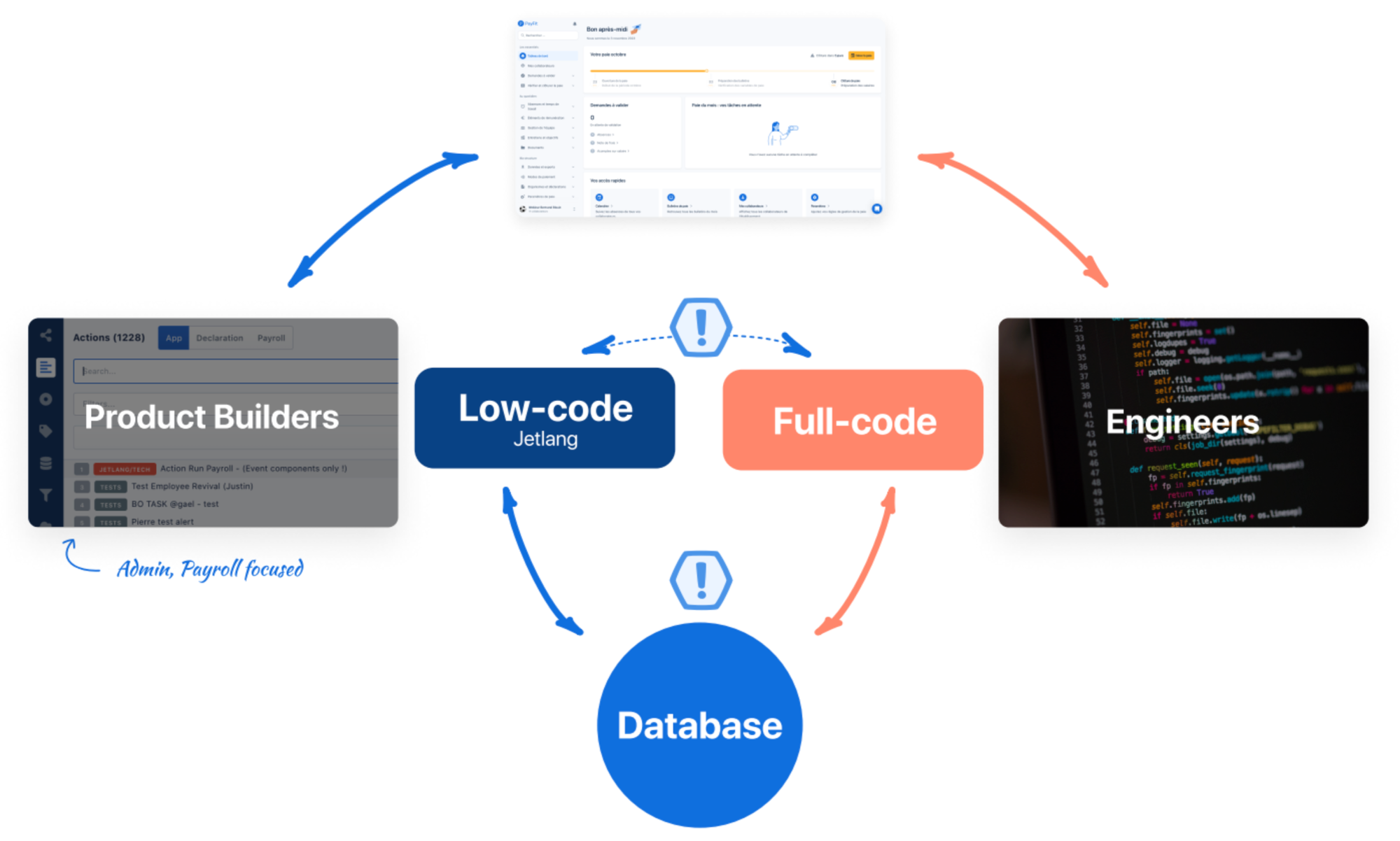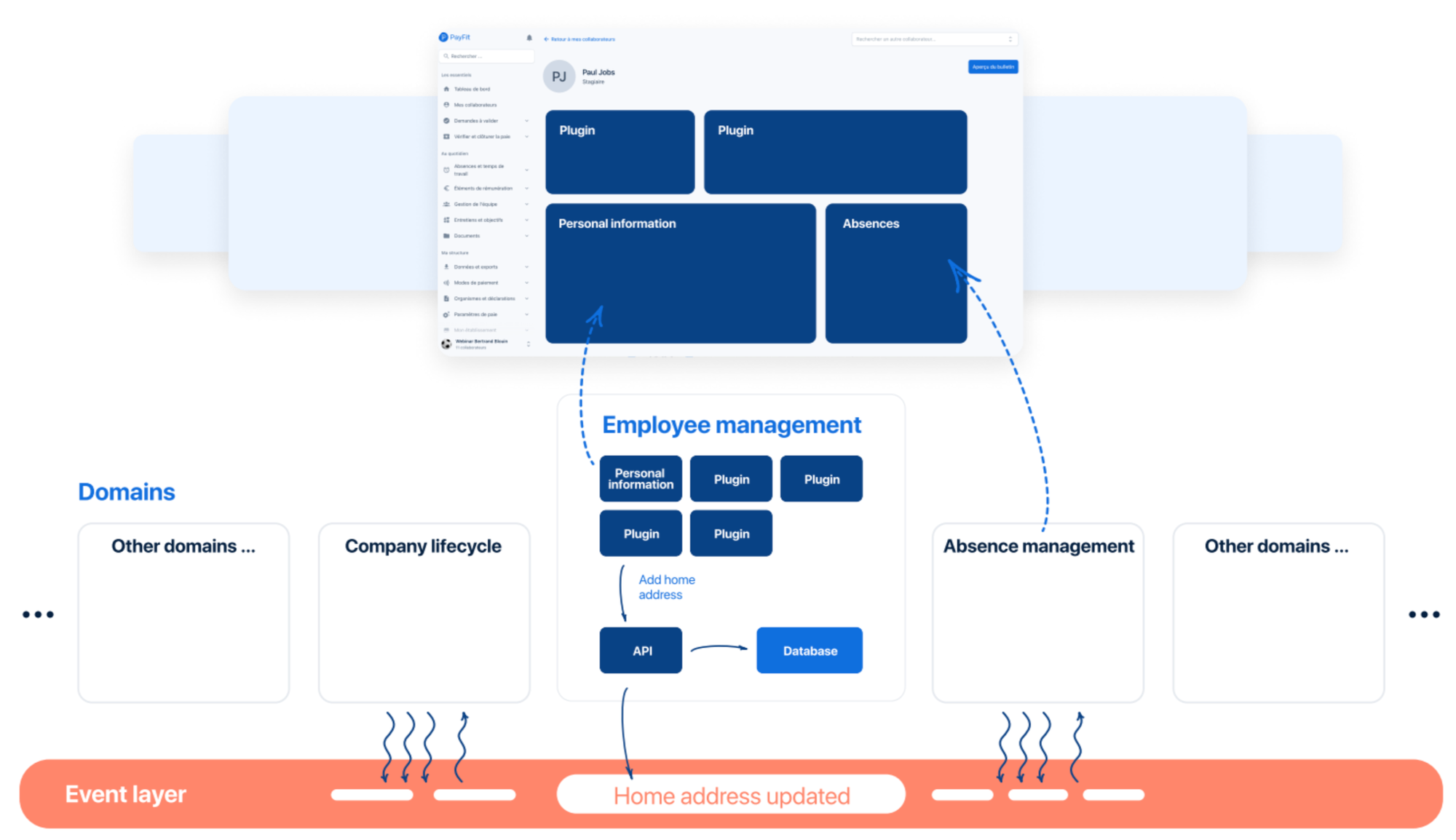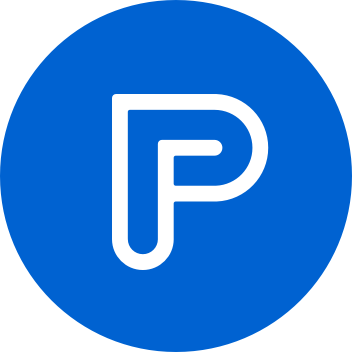Think of technical architecture as a tree. The roots represent the existing systems; they’re deep, established and provide foundations. But to grow and stay vibrant, the tree must constantly solidify its foundations, sprout new branches, adapting and reaching towards the sun.
This symbolises the need to evolve into a more flexible and modular structure, allowing for a diverse ecosystem to flourish in its canopy.
At PayFit, we have the same ambition with our tech architecture vision. We are building a future-proof technical architecture to support our mission to simplify payroll for VSBs & SMBs and enable employers and employees to grow together. One key element is being able to deliver a Software As A Service (SaaS) with a platform thinking that supports a large ecosystem of applications, including those provided by third parties.
Since 2023, we have been transitioning progressively towards our long-term architectural vision, and will continue to do so in 2024 and beyond. This is the most efficient way to continue to deliver and increase our value proposition iteratively.
1. Why we needed to transform
Some internal complexity…
The way the PayFit app has been built has served us well over the past years. It transformed us from a French startup to a European company serving over 10,000 customers and 200,000 employees across France, Spain and the UK. But we needed to recognise that it also had its limitations:
- The cohabitation between our internal low-code system, JetLang, and our more common full-code system is challenging. It comes with unclear responsibilities and multiple sources of truth for a given data and complex data updates.
- We relied on a monolithic data architecture, which means that we had one central database and one central way to update data in JetLang, called JetLang Action. On top of that, JetLang Action mixes user interface (UI), business logic and data modeling. This posed challenges to teams in charge of making our app evolve and adapt to the changing business needs.
- Overall, while we evolve in an inherently complex business environment (payroll and HR) with lots of quickly changing business rules, much of our complexity is accidental. Adding features in such large and complex applications became harder and harder because any code change could affect the whole system.

… that had an impact on our scalability
We are driven by our mission to help simplify payroll for millions of SMBs. Clearly, our internal complexity has sometimes slowed us down in terms of our ability to grow efficiently and serve our customers in the best possible way. This has had a negative impact on:
- The performance of our app – e.g. the time needed to display a page or result of calculation, and its stability (note: we already improved the performance of PayFit’s app by over 30% in 2023).
- Our ability to quickly evolve our app, whether it is for new experiences or to improve existing ones.
- The amount of effort, time and people needed to maintain our app.
Our ability to integrate efficiently with our partners.
2. Our vision
Understanding the new concepts
The long-term vision for our tech architecture is to break this large central application into several smaller pieces connected to each other.

- These smaller pieces correspond to the key concepts (domains) of our business: payroll, declarations, company lifecycle, employee management, contract management, compensation and benefits, time management, identity and roles & permissions, etc.
- When anything happens within one of these domains (user action, new information received, calculation completed, etc.), we will call this an event.Events will be shared between domains to ensure the impact of a change can be seen everywhere in the application.
Let’s look at an example
Here is an example that should help you understand how it will translate.

In this example, you can see that we build experiences (here, the employee space) for our customers where they see and interact with information coming from multiple different domains (employee management and absence management).
3. What’s in it for our customers and for PayFiters
For our customers
As we move towards this tech architecture vision, our customers benefit from it in a number of different ways:
- Improved user experience: Event-driven Architecture enables real-time data updates, meaning the application reflects changes (like payroll updates or employee information changes) almost instantaneously. This reduces the need for manual refreshes and ensures that users always have the latest information at their fingertips. As an example, an admin can receive live notifications of employees declaring absences and expenses, without refreshing the page. By having a more modular architecture, and adopting more modern technologies, we are also able to deliver more modern user experiences, which are critical to the goal of satisfied autonomy.
- Increased performance: The transformation helps further reduce loading time when using the app for a faster user experience. During the second semester of 2023, we have reduced global loading times by 30% compared to the same period in 2022. We also focused on essential experiences such as employee creation, employee offboarding and accounting, leading to a remarkable 70% boost in speed, on average.
- More features and updates: Read models live separately from other data models, meaning the app is able to evolve faster with new features or improvements being shipped more frequently to answer our customers’ needs. An event-driven architecture also facilitates the collection and processing of user interaction data in real-time. This data can then be used to personalise the user experience, such as customising dashboards based on user roles or preferences, or suggesting relevant Human Resource Information System (HRIS) actions.
- A platform enabling a rich ecosystem of partners: We know our customers use several different software. Being integrated with partners represents not only a great business opportunity to acquire more customers; it’s also something that many of our customers expect as they look to find additional ways to simplify how they run their business.
For PayFiters
Modernising our tech architecture comes with multiple benefits for PayFiters. We’ve listed the five main ones below:
- Better experience: PayFiters are all users of the app (whether it is as an employee, manager, admin or a member of the Customer Service team), so they benefit from the improvements mentioned above.
- Less maintenance: We expect that PayFiters will spend less time maintaining the run and managing incidents, and will be able to focus more on adding value to our customers.
- More business opportunities: The new architecture enables us to move towards our strategic goal to potentially offer distinct core products, easily integrated with/by external partners.
- Closer collaboration: Thanks to a better understanding of our domains and their boundaries, and clarifying ownership and responsibilities, collaboration between teams is made easier.
- Better ways of working: For Product Builders, the transformation will come with stronger tools to help them add even more value to our customers, as well as opportunities to build more sophisticated systems and workflows.
To conclude
As we move forward on this journey, customers and PayFiters will notice the progress towards our long-term vision for our tech architecture through the improvements that will be progressively released month after month in 2024. So stay tuned !



